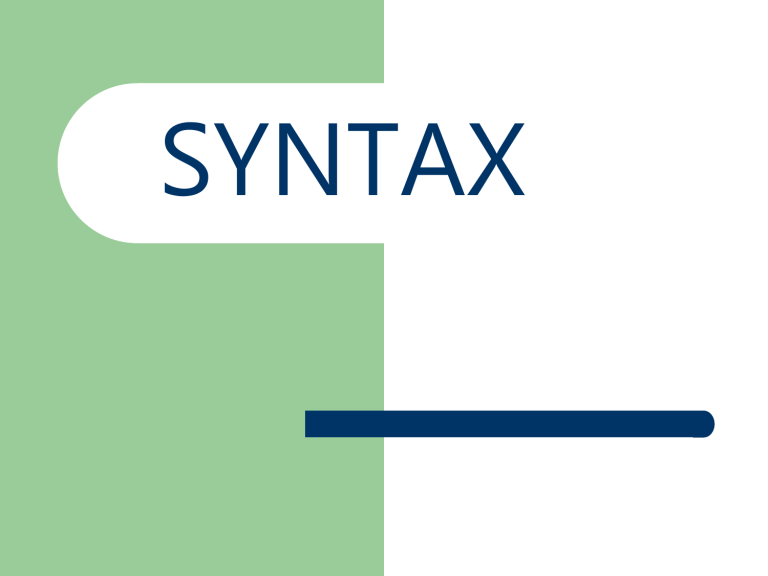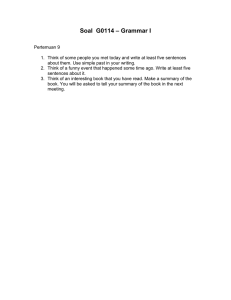
SYNTAX
What is syntax?
The study of the structure and
ordering of components within a
sentence.
The word syntax came from Greek
and literally meant “ a setting out
together” or “arrangement”.
Cont.
Structural analysis, immediate
constituent analysis and labeled
or bracketed sentences are
attempts to produce an accurate
analysis of the sequence or the
ordering “arrangement” of the
elements in the linear structure of
the sentence.
Generative grammar
Noam chomosky criticized
grammar that concentrate upon
the linear structure of the
sentence.
Cont.
He concentrated upon a kind of
grammar that has a set of rules
that generates an infinite
number of sentences in the
language. That is why it is
called generative grammar.
Some properties of the grammar
A grammar of this kind must have a
number of properties:
1- The grammar will generate all the
well-formed syntactic structures
(sentences) of the language and fail
to generate any ill-formed
structures.
To account for all grammatical sentences.
Property no.1
Enormous crickets in pink
socks danced at the prom.
Milk the crumbled verb a.
Colorless green ideas sleep
furiously.
Cont.
2- This grammar will have a finite
number of rules, but will be
capable of generating an
infinite number of well-formed
structures. In this way, the
productivity of language would be
captured within the grammar.
Property no.2
S
NP
NP
Art
+
+
VP
N
Cont.
3- This grammar must be
recursive.
Recursiveness is the capacity
to be applied more than once
in generating a structure.
Property no. 3
I hate war .
You know that I hate war.
He knows that you know
that I hate war.
Cont.
4- This grammar should be also
capable of revealing the
basis of two phenomena :
first, how some superficially
distinct sentences are closely
related,
Property no.4
The student solved the
problem.
The problem was
solved by the student.
Cont. property no. 4
And
second, how some
superficially similar
sentences are in fact distinct.
Cont. property no. 4
Annie whacked a man with an
umbrella.
Visiting relatives can be
boring.
The hatred of the killers
Deep and surface structure
In traditional grammar, we have
passive and active sentences.
But the distinction between
them, is a difference in their
surface structure, that is, the
syntactic form.
Cont.
However, the two sentences are
very closely related, even
identical at some less
“superficial” level. The other
“underlying” level has been
called their deep structure.
Deep structure (Def.)
A central theoretical term; opposed
to surface structure.“ Deep
structure” is the abstract
SYNTACTIC REPRESENTATION of a
SENTENCE- an UNDERLYING
LEVEL of structural organization
which specifies all the factors
governing the sentence should be
interpreted.
Cont. (def.)
.
This level provides information
which enables us to distinguish
between the alternative
interpretations of sentences
which have the same surface
form (i.e. they are
AMBIGUOUS).
Cont. (def.)
.
It is also a way of relating
sentences which have different
surface forms but the same
underlying meaning( active and
passive sentences).
Active vs. passive
The student solved the
problem
The problem was solved by
the student.
Structural ambiguity (def.)
The general sense of this term,
referring to a word or a sentence
which expresses more than one
meaning, is found in Linguistics ,
but several types of ambiguity are
recognized. The most widely
discussed in recent years is
structural ambiguity.
Cont. (def.)
In transformational ambiguity,
the alternative semantic
representations can be
shown only by relating the
ambiguous sentence to
different structures.
Cont.
Annie whacked the man with
an umbrella.
Annie had an umbrella and she
whacked the man with it.
Annie whacked a man and the man
happened to be carrying an umbrella.
Cont.
Thus, the sentence is ambiguous.
It has two different underlying
interpretations which would be
represented differently in the
deep structure.
Cont.
Also, Phrases can be also
ambiguous:
The hatred of the killers
1) The killers hated someone
2) Someone hated the killers
Cont. (def.)
So, the grammar must be capable
of showing how a single
underling, abstract
representation can become
different surface structures.
Different approaches
There are different approaches to
producing a complete syntactic
description of a language.
Cont.
For some, the only relevant
issues are syntactic ones, that is,
how to describe structure,
independently of “meaning”
considerations.
For others, the “meaning
component” is primary.
Symbols used in syntactic description
Before we look at some basic features of
the original analytic approach, we need
to be introduced to the symbols related
to that approach.
N (= noun)
S (= sentence)
Art (= article)
“ consists of”
For example :
NP
Art
N
Cont.
(
) = something optional
The green book
For example
NP
NP
NP
}
Art ( Adj ) N
Art N
pronoun
NP proper noun
{
Art N
pronoun
proper noun
Cont.
S SENTENCE
PN proper noun
Art article
NP noun phrase
Pro
Adj
pronoun
adjective
Prep
preposition
PP Prep. phrase
* = ungrammatical sequence
consists of
Labeled tree diagram
[ [The] [monkey]]
NP
Art
N
This is a linear sequence of
constituents.
Labeled and bracketed sentence
Labeled tree diagram
NP
ART
N
This is a
hierarchically
organized analysis.
This is a tree
diagram.
The
monkey
S
NP
Art
VP
N
V
NP
Art
The
monkey
ate
a
N
banana
Phrase structure rules
Phrase structure rules are the rules
used in applying the tree diagram.
S
S
NP
VP
NP VP
Lexical Rules
We can also have lexical rules
which indicate the words to be
used for constituents such as,
N
{ boy, girl, dog }
Transformational Rules
1) John helped Mary
yesterday.
2) Yesterday John helped
Mary.
Cont.
s
S
NP
VP
Adv NP
VP
V
V
NP Adv
NP
